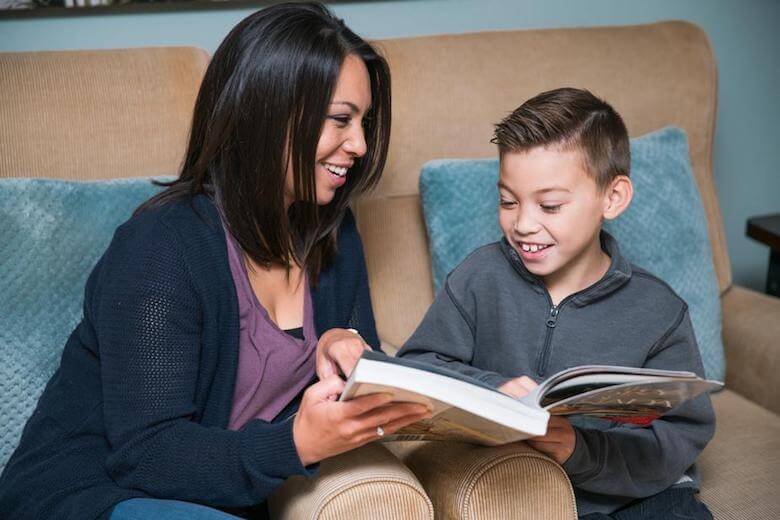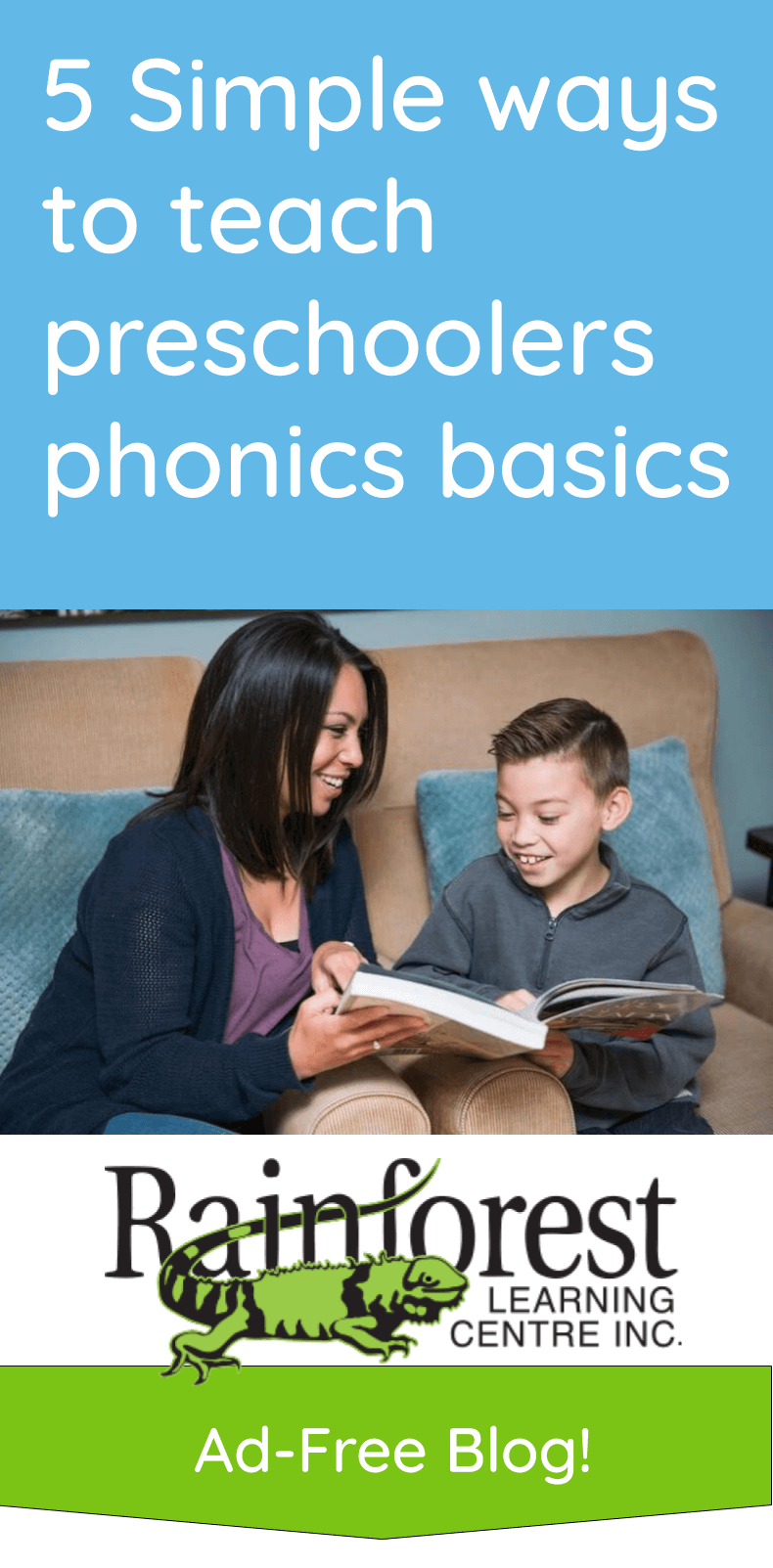
When teaching preschoolers to read, there are multiple methods that can be used. The more popular one that is advocated for, and probably the one you learned by, is called phonics. That is, learning to ‘blend’ letter sounds to create complete words. This is opposed to the method of sight reading, which is based more on memorizing whole words at a time. We discussed the pros and cons of these different methods on our blog, here.
In this article, we’ll demonstrate how simple it can be to teach preschoolers phonics basics. Phonics are like the ‘building blocks’ to learning words, which then form sentences and meaning. These ‘building blocks’ can start small, and ultra-focused. That also gives room for a lot of creativity when teaching these letter pairs or combinations. And, it helps when teaching kids with different learning styles. Visual, auditory, kinaesthetic, linguistic – they can all be used to teach phonics!
Below are ideas for teaching phonics as a parent or preschool teachers:
1) Recite and sing alphabet songs with sounds and word associations
It is very important for children to start learning that the letters they know by name have sounds associated with them. If you taught a preschooler their alphabet with the ‘a-b-c’ song, you can graduate them to songs and recitations of the sounds that letters make. This can involve words that start with those sounds.
For example, “A” is for “a-a-a…Apple!” and “B” is for “buh-buh-buh…Box!”
Songs make learning fun. And we all know how easily a song gets stuck in our heads! Use the following examples of letter-sound association songs with your toddler or preschooler:
https://www.youtube.com/watch?v=BELlZKpi1Zs
https://www.youtube.com/watch?v=pyKdUpJQBTY
See related on our blog: 12 YouTube channels for toddlers and preschoolers
2) Use charts and flashcards with phoneme sounds and combinations, not whole words
Charts can help young kids visualize their phonemes. It can show them, in list form, what all the possible two-letter combinations are, for instance. How many letters can go before “A,” for example? There is, “ba,” “da,” “fa,” and so on. As this vlogger says, if a child finds a chart with too many phonemes hard to focus on, these can be turned into flash cards.
There are countless phonics charts available online, especially on Pinterest. They can be pre-made teacher-marketed products, free printables or drawn yourself on large posters and cards. They can contain pictures for word-associations, rhymes, matching games, and more. Here is just one Pinterest board that may help you get started:
https://www.pinterest.ca/pin/358599189054497575/?lp=true
3) Play with food manipulatives to teach phonics inspiration
Like we mentioned in our article about teaching the alphabet to preschoolers, kids love playing with food. So, you can use that!
With phonics, you are not just teaching letter names, however. You are specifically trying to get children to combine letters, to form sounds. So, focus on food activities that don’t isolate letters.
For example, you can use Cheerios to let kids form “oo” words, as explained on this article:
https://missgiraffesclass.blogspot.com/2015/04/five-for-friday-may-1-2015.html?m=1
This can be done with any letter-shaped food, like alphabet pasta, or even your own, homemade letter cookies. By the way, dough-made letters in three dimensions help with dyslexia too!
You can also make mini cupcakes decorated with icing letters that form the syllables in a word. The child can line them up until they form a word. Their reward? Eating them! Or sharing them…!
4) Make DIY crafts for learning phonics combinations
Use simple paper crafts and home materials to make your own ‘toys’ for learning phonics combinations. These don’t necessarily have to produce real words – they can be much simpler, so that a child starts to learn those ‘building blocks’ of letter-sound combinations that eventually form words.
For example, you can cut up toilet paper rolls, draw letter combinations, then thread them on a hanger for a phonics manipulator toy!
Instructions are at the following link:
https://www.notimeforflashcards.com/2013/01/rhyming-activity-for-kids.html
You can also draw letters, or combinations of letters on sticks or spoons, and ask the kids to mix and match them, to make phonetic sounds. Here is an example using paper letter cut outs on popsicle sticks:
https://thesmokies.momexplores.com/letter-sound-identification-game/
A phonics ‘flip book’ is also easy to make. Glue or tape a hand-made paper booklet with variable sounds, next to a constant letter sound or grouping, on a solid piece of paper. The child can flip through the book, and read out the sounds that each formation makes, when the page is turned.
Or, you can put two flip books together, to form the same idea, but with more ‘mix and match’ options. These are called ‘word family’ flip books. See the following link for an example:
https://kidsactivitiesblog.com/6412/word-families-flip-book
Another easy craft is to draw word families or sounds onto cups, that kids can then stack. See the following link for an example:
http://thirdgradethinkers8.blogspot.com/2011/07/word-work-station-cup-stacking.html?m=1
There are plenty more ideas you can find online!
5) Read rhyming books and poems to show word constructs with phonics
There are plenty of books that emphasize simple words to teach phonics. Many of these rhyme, too. Think: “The Cat in The Hat” by Dr. Seuss.
One of the criticisms of systematic phonics, compared to word-memorization techniques, is that sometimes, kids learn meaningless words, and lose out on the joy of reading. However, you can combat this problem by letting kids practice what they’ve learned. Show them that books can contain the words of ‘real’ objects they know how to say already. For example, animals and shapes.
When poems and rhymes are introduced, this can sound funny to kids. It can also show them how easily words can morph. It’s ok if they make up words that aren’t real when they learn to rhyme. Play along, so they can see that words are based on the blending of sounds. Of course, you can tell them that these aren’t real words or things. But there’s no reason not to make those sounds! They’re funny!
To conclude: teaching preschoolers phonics basics is easy and fun!
As you can see from the simple activities above, teaching phonics can be a very simple process. It can also be a creative one, with lots of fun activities. We haven’t even covered the games you can play with phonics! But getting started with above 5 ideas will surely keep you and your preschooler busy for a while, and learning a lot!
See more on our blog:
- 5 Easy ways to teach the alphabet to preschoolers
- How to teach digraphs to preschool children (6 ways)
- Why is literacy crucial in the early years? How can parents and preschools help with reading skills?
- Does my child need a speech therapist? Here is what to know
- What is the best way to teach word recognition to early childhood readers?
- Symptoms of dyslexia in preschool-age kids and how to help at daycare
- How to recognize early vision problems in toddlers and preschoolers
